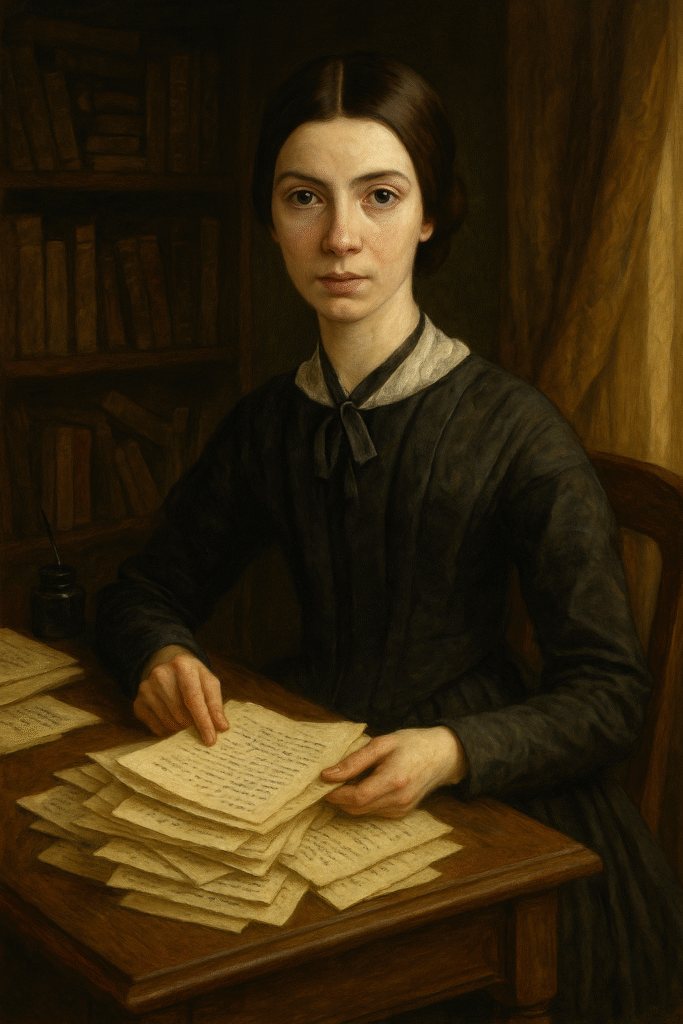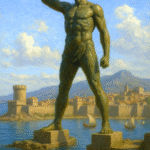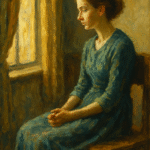Emily Dickinson, one of the most profound voices in American poetry, lived a life marked by solitary reflection and profound creativity. Although she produced nearly 1,800 poems during her lifetime, only a fraction was published during her lifetime. Many of her works remained hidden, even from her closest friends and family. This article delves into the reasons why Dickinson chose to keep her work under wraps, the implications of her hidden poems for our understanding of her literary legacy, and the broader context of female authorship at a time when women’s voices were often silenced.
Introduction to Emily Dickinson’s Life and Context of Her Writing
Emily Dickinson was born on December 10, 1830, in Amherst, Massachusetts, into a prominent family with deep roots in both the community and academia. Her father, Edward Dickinson, was a congressman, and her family was well-respected, yet Emily often withdrew from the world around her. Throughout her life, she had very few close friendships, with most of her connections being cultivated through letters, particularly with her close friend and sister-in-law, Susan Gilbert Dickinson.
Dickinson’s poetry was largely influenced by the tumultuous social landscape of 19th-century America. Striving for authenticity in her voice, she wrote during a time of great upheaval, including the Civil War and women’s budding rights movements. Traditional societal roles of women often relegated them to the domestic sphere, yet Dickinson’s poetry transcended these confines. Her choice to write and keep her poems hidden reflects a struggle between conformity and the desire for personal independence.
The Historical Context of Dickinson’s Life and Work
The era in which Dickinson wrote was characterized by a struggle between emerging modernity and traditional values. The mid-19th century was especially vibrant in literary circles, with the Transcendentalist movement led by figures such as Ralph Waldo Emerson and Henry David Thoreau inspiring American writers to explore individualism and nature.
However, women writers faced immense hurdles in gaining recognition. While some female authors, such as Louisa May Alcott, found a market for their books, many others, including Dickinson, faced barriers due to societal norms that associated intellectual pursuits with masculinity. Consequently, Dickinson’s decision to keep her poems private can be viewed as a form of resistance against the constraints imposed on women in literature.
Examination of the Hidden Poems and What They Reveal
Although not all of Emily Dickinson’s 1,800 poems were hidden, the small number she chose to publish during her lifetime reflects her struggle with self-exposure and artistic integrity. The posthumous revealing of her hidden poems dramatically altered the literary landscape’s perception of her and offers a rich tapestry of insights into her psyche and artistry.
Analysis of Specific Hidden Poems
Let’s take a closer look at a few of Dickinson’s hidden gems that shed light on her motivations and experiences. The poems reveal intricate layers of thought, emotion, and philosophical inquiry that go beyond conventional interpretations:
1. “There’s a certain Slant of light” (Poem 254)
- In this poem, Dickinson speaks of the oppressive and foreboding nature of the winter light. The imagery evokes feelings of despair and melancholy, illustrating her profound psychological insight into depression. The multidimensionality of this work points to the artist’s internal battles, and the desire to conceal such vulnerable emotions potentially reflects a societal perception of weakness.
2. “I dwell in Possibility” (Poem 657)
- This poem emphasizes Dickinson’s belief in the limitless potential of imagination and creativity. By claiming she prefers the possibilities over the certainty of her own poetry, she embraces an exhilarating, albeit risky, approach to her art. It starkly contrasts the stringent norms of her time, which often stifled creativity—especially among women.
3. “I heard a Fly buzz—when I died” (Poem 465)
- This haunting poem contemplates death with stark imagery that captures the intersection of life and mortality, blending resignation with an acute awareness of the finality that death brings. Dickinson’s voice here signifies both a surrender and a confrontation with the existential nature of her existence. Keeping this work hidden may reflect her ambivalence about public exposure and the raw exploration of such a dark theme.
Discussion on the Broader Implications for Literature and Female Authorship
The Psychological Motivations Behind Keeping Her Poetry Private
Emily Dickinson’s decision to keep her poetry private can be viewed from several psychological angles, including fear of judgment and a desire for control over her literary identity. She was acutely aware of the societal expectations placed on women and the perceptions surrounding female authorship. The act of writing itself served as an outlet for Dickinson to process her experiences and emotions, and public exposure could detract from this personal sanctuary.
Similarly, the notion of authorship during her lifetime was often male-dominated, with women frequently reduced to the roles of mother or wife. This context could have led Dickinson to view literary fame as a double-edged sword; while it could provide recognition, it also came with scrutiny that might stifle her artistic expression.
The Impact of Revealing Hidden Poems on Contemporary Understanding of Her Literary Significance
The discovery and publication of Emily Dickinson’s hidden poems have expanded the understanding of her literary contribution significantly. Her later works received critical acclaim and have been recognized for their innovative use of language, form, and themes that explore death, immortality, and the natural world. Poets and critics today regard her as a precursor to modernist poetry, yet her isolation and desire to conceal her work complicate her legacy.
These hidden poems serve as a reminder of the need to challenge conventional notions of authorship and creativity. By analyzing her concealed collection, contemporary readers better understand the depth and breadth of female voices in a patriarchal society. Dickinson’s reluctance to share her work underscores the larger issues of gender, societal constraints, and individual agency.
The Legacy and Influence of Emily Dickinson
Through her unique voice, Emily Dickinson has cultivated a legacy that resonates deeply with feminist literary scholars, modern poets, and enthusiasts who grapple with the themes of isolation, the nature of reality, and the exploration of inner landscapes. Her posthumous fame has sparked essential discussions surrounding the constraints of female authorship and the importance of recognizing women’s contributions in literature’s historical canon.
As Dickinson’s hidden poems come to light, they offer a nuanced understanding of her art’s complexity and impact. They highlight the significance of revealing these works, influencing how we conceive of authorship and its implications for emerging female writers.
Conclusion
In her lifetime, Emily Dickinson may have chosen to keep her work concealed, but the literary world profoundly benefitted from her deep and complex explorations of life and existence. Her hidden poems are not merely artifacts of a solitary existence; they embody the resilience of a woman who negotiated the limitations imposed by society. By examining her life, the hidden facets of her poetry, and the broader canvas of literary history, we illuminate not only Dickinson’s contributions but also the continuing evolution of women’s voices in literature.
Summary
Emily Dickinson’s hidden poems provide enduring lessons about creative expression, identity, and individuality within the constraints of society. Her reluctance to share her work highlights psychological tortures women have faced in literature, and the later unveiling of her poems has transformed our understanding of her legacy, signaling a crucial movement towards recognizing female writers in the literary canon.
FAQs
What motivated Emily Dickinson to keep her poems secret?
Emily Dickinson’s choice to keep her poems secret stemmed from a combination of societal expectations, fear of judgment, and a desire for control over her artistic expression. The societal norms of the 19th century often marginalized female voices, making her reluctance to share her work understandable.
How have Dickinson’s hidden poems changed perceptions of her work?
The unveiling of Dickinson’s hidden poems has significantly enriched our understanding of her as a poet. It has showcased her innovative approach to language and explored deep themes, fundamentally changing how scholars and readers alike perceive her contribution to American literature.
What is the significance of Emily Dickinson in the context of female authorship?
Emily Dickinson is a pivotal figure in the history of female authorship. Her life and work challenge the narratives that often relegated women to the margins of literary history, highlighting the essential role that female voices play in shaping literature and cultural discourse.
How can modern readers engage with Dickinson’s hidden poems?
Modern readers can engage with Dickinson’s hidden poems by exploring her complete works available in published collections such as “The Poems of Emily Dickinson,” analyzing her unique style, and participating in discussions on how her themes of isolation, love, and death resonate even today.
Why are Dickinson’s themes still relevant today?
The themes explored in Dickinson’s poetry—including identity, existentialism, and the complexity of emotions—are timeless and continue to resonate with contemporary readers. Her unique voice encourages introspection and invites us to examine our own experiences and feelings, making her work as relevant today as it was in the 19th century.


